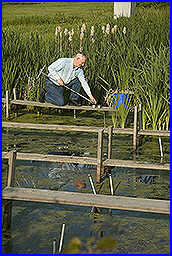



Bringing Wetlands to the Farm
US - Most farmers and ranchers aren't near any wetlands, which are nature's tool for filtering impurities out of waterways—and would help keep excess crop nutrients and livestock waste out of rivers and streams. |
| An ARS soil scientist collects bottom sediments from a constructed wetland. This wetland, located alongside a crop field, removes nitrate and sediment from field drainage water so they won't end up in streams. In dry years, water from the wetlands can be recycled back onto fields to boost yields. |
That's why scientists at the Coastal Plains Soil, Water and Plant Research Center of the Agricultural Research Service in Florence, S.C., are exploring the use of constructed wetlands as a way to bring these natural filters to farmers.
According to Florence research leader Patrick Hunt, the constructed-wetlands studies are in keeping with the center's mission to anticipate, identify and solve natural resource problems in agriculture that are important to the United States in general, and to the Southeast Coastal Plain in particular.
The Florence lab addresses a problem unique to its region: the fact that soils in the Southeast Coastal Plain are very sandy and hold very little water. This makes runoff from farms and livestock operations an especially big problem that has grown over the past decade as animal production has increased.
Constructed wetlands have been used for decades for municipal wastewater treatment. They work on the principle of denitrification, a process in which microorganisms convert nitrogen that’s in plant-available form into an inert gas. In studies, Hunt, soil scientist Ariel Szogi, agricultural engineer Kenneth Stone and other Florence researchers have found that constructed wetlands can remove about half of the total suspended solids in water and about 60 percent of the nitrogen.
According to Hunt, the keys to constructed wetlands systems are marsh plants, aeration and drainage. The wetlands system must have a sloped bottom and shallow water at the entry point. The shallow water assures crucial interaction with oxygen.
ThePoultrySite News Desk








